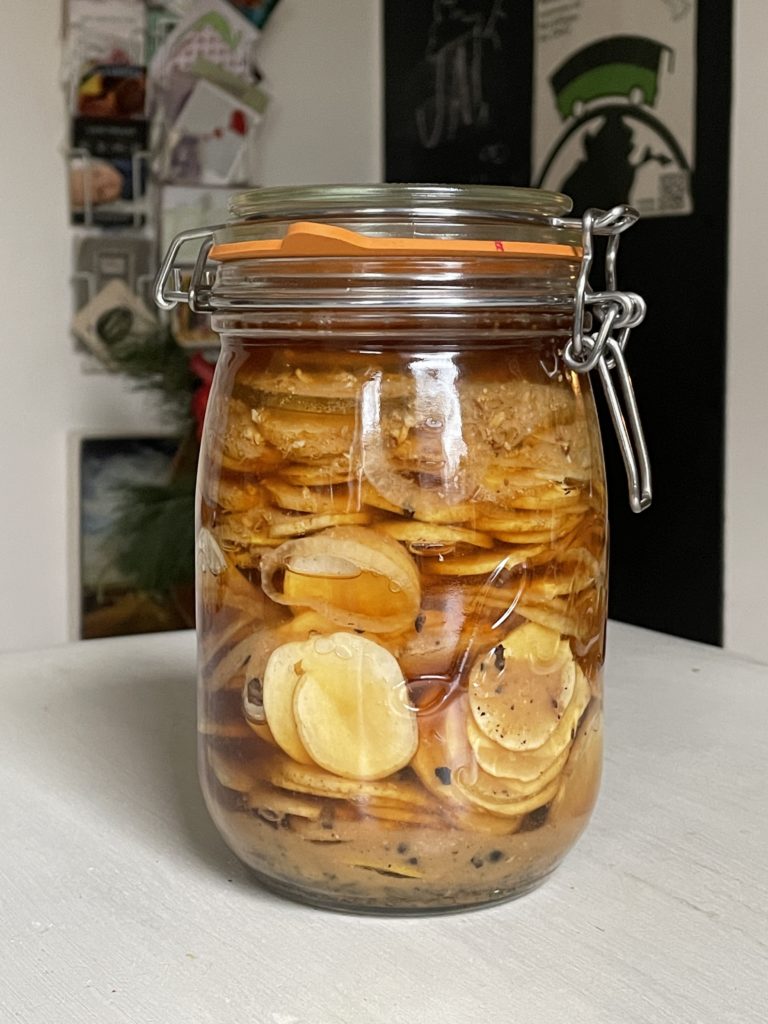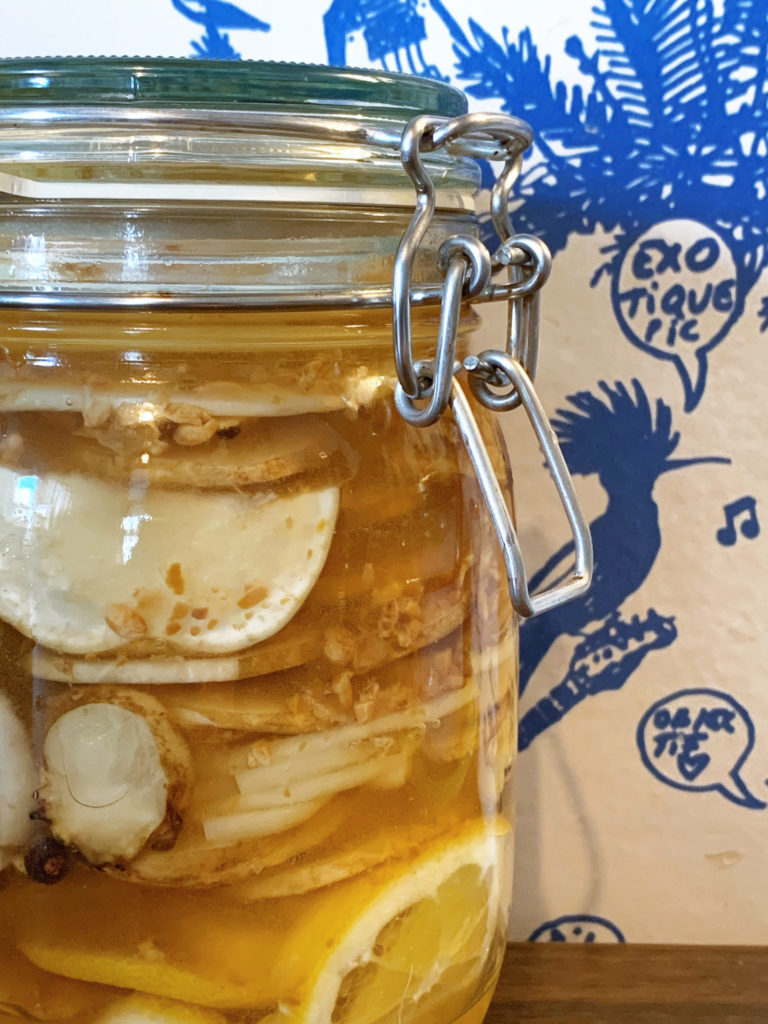Especially in autumn, at the beginning of the season, I receive many questions about how to ferment sunchokes. After the vegetable had lost its importance over the centuries, the popularity of the tubers has been growing strongly again for several years.
Sunchoke, also known as Jerusalem artichoke, horse potato or earth truffle, has a slightly nutty to sweet aroma and is considered a healthy, fiber-containing and low-calorie alternative to the ever-popular potato. Instead of the starch predominant in potatoes, sunchokes contain the carbohydrate inulin, which has many positive properties.
Inulin is a prebiotic dietary fiber
- Like all dietary fibers, inulin saturates well, binds liquids and swells in the process. The digestive system remains active.
- The plant energy in inulin cannot be processed in the human metabolism. Therefore, it has no influence on the insulin level, which is why it is also well tolerated by diabetics.
- Inulin can prevent hunger cravings by keeping blood sugar levels more constant and help with weight loss.
- Im Dickdarm dient Inulin Bifidobakterien als Energiequelle und wird von ihnen verstoffwechselt. Inulinaufnahme kann den menschlichen Darm mit Bifidobakterien anreichern und krankmachende Keime verdrängen.
Fermenting sunchokes improves tolerance
Although the inulin in sunchoke has so many positive effects, it can also cause problems. Consumption, especially of raw tubers, can lead to side effects such as flatulence or diarrhea. One reason for this is that the fermentation of inulin by intestinal bacteria proceeds very quickly. Unpleasant side effects can be observed especially in people with intestinal flora accustomed to a diet of simple carbohydrates.
The fermentation of sunchokes preempts these digestive processes and makes it far more digestible for all people. If you do not yet know your personal tolerance, I recommend you to feel your way slowly.


INGREDIENTS
For a 0.75 liter jar you need
- 6-7 sunchokes
- 1 organic lemon
- ½ white onion
- 8-10 allspice seeds
- 1 -2 tbsp miso
- 500 ml water
- 10 gr. salt
PREPARATION
Scrub the sunchokes well and peel if needed. Although the peel bothers me on carrots, I like it on these tubers and leave it on. Then cut into thin slices. This is done quick and easy with a vegetable slicer.
Cut four very thin slices from the lemon. Here more is not more, too much lemon quickly becomes unpleasantly bitter.
Also cut the halved onion into thin crescent slices.
Mix the salt and miso in the water until dissolved. I like to use coarse miso with pieces of the legumes or grains still apparent, for example homemade genmai miso. However, the ferment will also succeed with smoother miso without texture.
The sunchoke ferment with miso and lemon is an umami bomb
Place the allspice seeds in the bottom of your fermentation vessel, layer in the sunchoke, lemon and onion slices. Pour on the brine and weigh down with flat, wide weights. The filling level should go to about 2-3 cm below the rim. You can also fill your vessel very full, then you get around the weights. In this case, some brine will probably leak out during the fermentation, because the filling level will increase with the development of carbonic acid. You should protect your furniture from leaking brine, so it is best to place your vessel on a deep plate or in a bowl.
Let it ferment for 3-4 weeks. To prevent the sunchoke from becoming too soft, you should let it ferment in a cooler place. Under 20°C is ideal.
Of course, like all ferments, this ferment can be stored for longer periods.
Another great ferment with sunchokes comes from my second home in California. I call it Berkeley Haze.






Liebe Katsu,
ich “arbeite” mich mit viel Freude durch deinen Blog. Im Sommer habe ich mich an den Umeboshi versucht – alles hat funktioniert, aber meine schmecken hauptsächlich sehr salzig und kaum sauer. Hätte ich irgendwas anders machen sollen /können? Können sie sich trocken im Glas geschmacklich noch verändern?
Außerdem habe ich Topinambur mit Miso angesetzt und es passiert fast gar nichts (seit dem 6.11.), am Wochenende habe ich dann auch noch Topinambur mit lila Möhren auf den Weg gebracht (ich liebe Topinambur…) und dieses Ferment ist ausgesprochen explosiv 😮
Hast du Erklärungen für mich?
Danke für deine Mühe und für deinen tollen Blog!
Liebe Grüße Andrea
Hej Andrea,
das ist ja toll, dass Du so viele meiner Rezepte ausprobierst. Dass die Umeboshi nicht sauer werden, kann zwei Gründe haben. Entweder war nicht genug Zucker vorhanden, oder sie standen zu kalt. Probier mal, noch einen Löffel Zucker mit der Lake verrührt hinzuzugeben und sie etwas wärmer zu stellen, vielleicht verändert sich noch was.
Topinambur mit Miso kann gut noch länger stehen. Ich weiss nicht, wie warm es bei Dir ist, aber wenn die Fermente kühler stehen, kommen sie langsamer in Gang. Die Säure der Zitronen hemmt zusätzlich. Beim Topinambur mit Möhren sind extrem viele Kohlehydrate vorhanden, deswegen ist das ein sehr aktives Ferment.
Ich hoffe, Du bekommst alle Gläser noch zu Deiner Zufriedenheit vollendet!
Katsu
Liebe Katsu, danke für deine detaillierte Antwort. Das klingt alles sehr plausibel und ich werde weiter experimentieren!
Hallo Katsu, habe heute zufällig deine Seite gefunden und bin sehr begeistert von deiner Kreativität. Ich fermentiere seit ein paar Jahren eher “traditionell” aber ich werde jetzt sicher das eine oder andere ausprobieren. Topinambur haben wir immer jede Menge im Garten und ich würde das Rezept gerne ausprobieren. Kann ich den Miso auch durch irgendetwas anderes ersetzen? Ich bin nicht so der Sojafreund ;). Dir ganz herzlichen Dank für deine Arbeit, die du dir mit dieser Seite machst. Sensationell gut!!! LG aus Ungarn Sandra
Hej Sandra,
ich mache mein Miso häufig aus Erbsen oder Kichererbsen, das kannst du auch machen. Mittlerweile gibt es Miso aus alternativen Hülsenfrüchten sogar bei einigen kleinen Manufakturen zu kaufen, falls dir der Aufwand des Selbermachens zu gross ist. Wenn ich es in diesem Rezept ersetzen wollen würde, dann durch einen Schuss Sojasauce – aber das hilft dir ja leider nicht weiter, weil dir Soja nicht gefällt.
Mein anderes Topinamburrezept kommt ohne aus, vielleicht ist das was für dich?
Gutes Gelingen,
Katsu
Hallo Katsu
Vielen Dank für das Rezept. Werde es auf jeden Fall gleich nachmachen.Ich liebe Topinambur in jeder Form. Bin allerdings bis jetzt vom klassischen Topinambur Ferment immer enttäuscht worden wg der Konsistenz der Lake. Kennst du das? Wenn man was aus dem Glas holt und die Lake so furchtbar schleimig ist, dass sie Fäden zieht? Der Geschmack ist wunderbar, aber man kommt nur schwer gegen den Anblick. Hast du einen Tipp, woran es liegen könnte? Vielleicht falsche Temperatur?
Hej Elvira,
was du da beobachtest, nennt sich dextran. Lies gerne, was ich dazu geschrieben habe.
Abhilfe? Schneide die Knollen etwas gröber, das sollte helfen. Oder lass die Fermente länger stehen, Dextran baut sich auch wieder ab. Oder spüle vor dem Verzehr, wenn dich die Konsistenz sehr stört. Bei rote Bete mag ich die dickflüssige Lake ganz gerne, das macht einen so schönen lackierten Effekt.
Gutes Gelingen!
Katsu